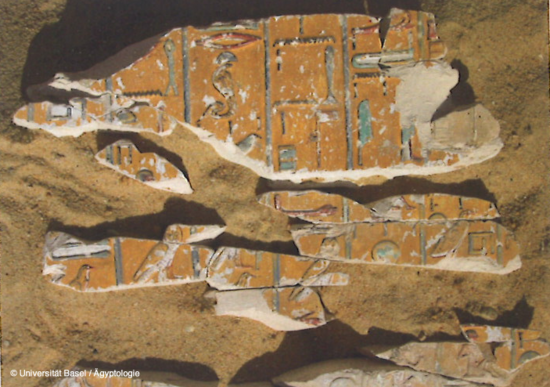New research on the most famous tomb in the Valley of the Kings: Sethos I KV 17
In the vicinity of the tomb of Ramesses X. (KV 18) objects from the neighboring tomb of Sethos I (KV 17) were discovered. The tomb of Sethos I. is the most famous one in the Valley of the Kings ("Belzoni's tomb") next to that of Tutankhamun.
Our finds from the tomb of Sethos I are on the one hand objects which belonged to the tomb furnishings, on the other hand wall and ceiling fragments. The latter, with their decorative remains, lead to new questions about the construction history of the tomb.
Thanks to the new finds from Basel from the surroundings of tombs KV 18 and 17, everything now indicates that the sarcophagus hall of the most famous tomb in the Valley of the Kings underwent an architectural and iconographic remodeling - probably due to a ceiling collapse.
Team MISR
In the course of the work in the vicinity of the tomb of Ramesses X. KV 18 many fragments of walls and ceilings from the tomb of Sethos I. were found. In addition fragments were documented which had been stored for a long time in side rooms of the sarcophagus hall of KV 17. The investigations revealed interesting findings.
- Existing decorations can be supplemented (Fig. 2).
- While in the royal tombs of the Valley of the Kings before Sethos I the ceilings of the sarcophagus hall are flat, in Sethos I the ceiling is vaulted in the lower part. That this was not originally the case is shown, among other things, by flat fragments of ceiling decoration with astronomical representations, which are a duplicate of the existing vaulted ceiling decoration (Fig. 3). "For unknown reasons (perhaps due to an unforeseen collapse), the flat part of the ceiling was probably destroyed together with the astronomical scene and replaced by the present vaulted ceiling with the second version of the astronomical painting. The fragments of the first version were perhaps removed in the process and deposited together with other rubble in the outer tomb area" (F. Mauric-Barberio 2017, 121).
- Fragments of the wall decoration (Figs. 4-5) led to the following conclusion: "In the first decoration phase, the final text from the 1st hour of the Amduat was placed on the back wall of the burial chamber. The subsequent construction of the side chamber P [= Jc according to Theban Mapping Project, editor's note] caused the destruction of the lower half of the decoration due to the newly created large doorway. The upper part above the doorway had to be erased so that a second version of the text could be placed there. On the now reduced area, the text had to be engraved in a compressed form: by reducing the width of the columns and using shorter hieroglyphic spellings" (F. Mauric-Barberio 2017, 123).
The objects that belonged to the burial equipment are
- Fragments of calcite-alabaster from the sarcophagus of Sethos I (Fig. 6). They were recovered and documented by MISR and the Archaeological Research Centre in Egypt (ARCE) during the excavations. The more than 280 small fragments come from the lid of the sarcophagus. This is so far only known in parts (J. Bonomi / S. Sharpe, The Alabaster Sarcophagus of Oimenepthah I, King of Egypt now in Sir John Soanes Museum, Lincol's Inn Fields, London 1864).
- Also from the tomb of Sethos I are over 700 fragments of vessel inscriptions, the majority from wine amphorae (Fig. 7). The inscriptions contain information about the contents and production (origin, year, person responsible). From the analysis of the dignostic fragments it can be concluded that at least 100 wine amphorae were part of the burial equipment.
- Objects that can be attributed to the burial equipment of Sethos I are fragments of the Kanopenkastena made of calcite-alabaster, Uschebtis, amulets, fragments of furniture and other small finds, but also plant remains such as date seeds or the nut of a dum palm.

Publications on this topic
- H. Jenni / B. Lüscher / E. Paulin-Grothe, Funde, in: Das Grab Ramses' X.. (KV 18), ed. by H. Jenni. With contributions by A. Dorn, H. Jenni, B.a Lüscher, E. Paulin-Grothe, T. Schneider (Aegyptiaca Helvetica [AH], vol. 16), Basel: Schwabe 2000, 66-75.
- Studies on the tomb of Sethos' I of the Basel project "MISR: Mission Siptah - Ramses X.", compiled by Hanna Jenni, in: Sokar, vol. 14, 2007, 88-90.
- F. Mauric-Barberio, Le rôle des archives dans la reconstitution du décor perdu de la tombe de Séthi Ier, in: Egyptian & Egyptological Documents, Archives, Libraries [EDAL], vol. 1, 2009, 41-46 (+ 4 fig.).
- H. Jenni (en collaboration avec Florence Mauric-Barberio), La vallée des rois - ses tombeaux et ses ouvriers. Travaux concernant les tombes KV 17, 18, 32 et 47 menés par l'Institut d'Êgyptologie de l'Université de Bâle, in: Êgypte. Afrique et Orient, vol. 54, 2009, 11-24: 20-22.
- F. Mauric-Barberio, Les fragments décorés provenant de la tombe de Séthi Ier. Fouilles de la Mission MISR de l'université de Bâle dans la Vallée des Rois, in: Bulletin de la Société française d'égyptologie [BSFE], vol. 185, 2013, 15-30.
- Florence Mauric-Barberio, Countless New Wall, Pillar and Ceiling Fragments from the Tomb of Sethos I, in: Scanning Sethos. Die Wiedergeburt eines Pharaonengrabes, ed. by Antikenmuseum Basel and Sammlung Ludwig, Basel 2017, 118-129.
- Claudia Manser Stoll, Der Alabaster Sarcophag Sethos' I., in: Scanning Sethos. Die Wiedergeburt eines Pharaonengrabes, ed. by Antikenmuseum Basel and Sammlung Ludwig, Basel 2017, 130-133.
Quick Links










